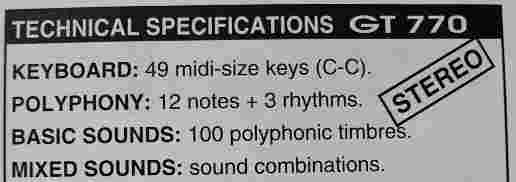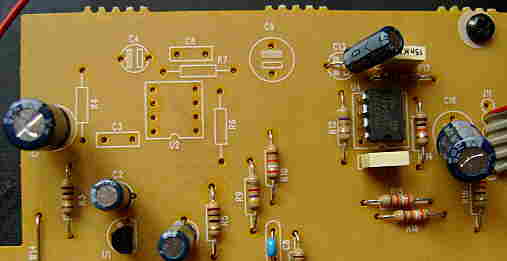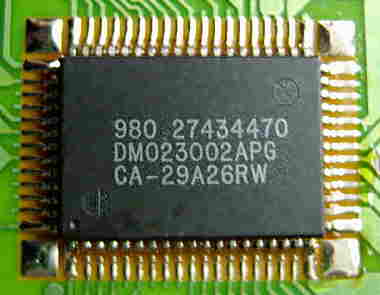|
|
This is the modern direct successor of the Bontempi GT 759; unlike the latter it has now 100 instead of 36 basic sounds and also some additional features. The preset sounds also include the 36 of the GT 759, but are programmed differently and tend to be warmer and less impulsive. Most acoustic instrument presets don't sound realistic, but they nicely remind to a cross of classic analogue synthesizer, Hammond organ and filtered multipulse squarewave organ timbres, including some lovely howling cheesy effect sounds. Generally the appeal of the sounds is astonishingly analogue for such a simple digital beginners keyboard despite it has only 8 bit sound resolution.
Also the lo-fi percussion sounds warmer and has more bass than with the GT 759. Fortunately at least in manual chord mode (with rhythm off) the chord section now accepts any disharmonic key combinations and not only establishment chords, and during accompaniments the chord memory can be disabled (stops accompaniment after key release). Also the drumpads can be enabled during accompaniment now. Beside normal rhythms there are 4 metronome patterns, those (unlike normal rhythms) can be used in manual chord mode.
Very annoying and almost fraudulent is that despite this instrument is claimed to be stereo (not just the small manual note, but also on the control panel writing and package box), also here the 2nd amplifier was omitted to reduce cost, thus the sound is only mono like with its predecessor Bontempi GT 759 (which didn't claim to be stereo). This instrument is very similar like the Bontempi GT 759 (including the solvent odour) thus see there for details.
 |
 |
 |
 |
 |
 |
 |
 |
The 100 preset sounds of this instrument are not programmed really realistic; some are even very off, but despite their coarse 8 bit DAC resolution they nicely remind to warm analogue synthesizer or Hammond organ timbres. The first 36 preset sound names correspond to the classic Bontempi 666 sounds engine (like with Bontempi GT 509, see there), but also these are programmed differently; especially they are warmer, have less impulsive envelopes and the ring speed of mandolin- like effect sounds is different. But the slower envelopes make picked strings like "harpsi" sound fairly unrealistic now. With sustain and/ or reverb enabled, ringing sounds (like mandolin) get messed up; their ring speed decreases dramatically (to <1Hz) because the ringing algorithm waits until the sustain/ reverb part of each clang fades silent until it retriggers the envelope. The GT 759 correctly started sustain only after key release and thus had no such flaw. Any 2 preset sounds can be combined as "mixed sounds" to create many new sounds, but like with the predecessor this mutes the 2nd suboscillator instead of simply layering both timbres. In the following I will describe none of the first 36 (see Bontempi GT 509 for these) unless they differ extremely. All sounds include reverb, thus I won't mention this here particularly.
Unlike with GT 759, the "square" here really reminds to a squarewave organ tone (with chorus and delayed vibrato); only the bass is too dull and thin for a squarewave instrument. The "telephone" tone toggle speed here varies strongly with the note pitch (the higher, the faster). "space piano" is a piano or e-bass layered with a dull Hammond organ with 6Hz vibrato. "bandoneon" sounds too bassy. "piano vox" is a sort of honkytonk piano (reminds to My Music Center) and semi- voice- like high note timbre. "fanfare" is a squawky synth brass with delayed vibrato that reminds to the famous Casio SA-series "brass ens." "synth lead" is a sort of brassy lead guitar with delayed vibrato. "synth bass" is a sort of sonorous Hammond organ bass. "synth horn" is a dull synth brass with chorus and delayed vibrato. "fat brass" is a bassy Hammond organ bass that grows thinner (like a flute) with vibrato. "twinkle piano" resembles a sonorous synth piano layered with a glockenspiel. The "harmonium" sounds not remotely like intended, but is a thinner variant of "fat brass". Also "analogic synth" is similar, but thinner with bassoon or oboe timbre in the bass range. "perc. flute" resembles a dull xylophone layered with a dull e-organ bass with vibrato. "untuned orch." resembles a decaying and slightly howling recorder flute layered with that e-organ bass. The "grand piano" is ok but sounds not really natural but like made on an analogue synth. "ethnic piano" is slightly detuned and hollower. Generally all piano sounds here resemble much those on Casio CZ-230S or analogue home organs. "60' organ" is a wooden(?) pipe organ rank or Hammond organ timbre with a little vibrato. "clarinet duo" is a dull woodwind timbre with chorus and delayed vibrato. The "contrabass" is not at all like intended; it starts percussive like a picked dull e-bass, but does not decay further but holds with some tremolo. Also "synth brass 2" is very similar, but 1 octave higher and slightly thinner. "soul organ" sounds like a high plain Hammond organ tone with percussive attack, layered with a short and dull cello or organ bass tone. The "funky clavi" has a way too slow attack rate and fades duller during its too short (linear?) decay; the timbre is rather tuba- or cello- like. "wood piano" is a rather dull honkytonk piano with hollow treble range. "pad piano" resembles an synth e-bass with detuned chorus layered with a flute with vibrato. "liturgic organ" is a sort of sonorous plain Hammond organ tone (resembling metal pipe organ rank) that grows thinner. "alien" is one of those great howling synth effect sounds; it resembles "ghost", but is more melodic and howls faster - like a short cello tone with howling strong 6Hz vibrato, layered with a thinner hollow synth piano with another vibrato (vibrato stops after key release). "jazz duo" resembles a vibraphone with detuned chorus and a brassy component. "fantasy" is similar but thinner and without sustain; it resembles more a vibraphone layered with a short and dull tuba tone or the like. The "rhodes" sounds not at all like that e-piano, since it has vibrato and is way too brassy in the mids and resembles a hollow e-bass in the bass range. "orch. trumpets" is a brass ensemble timbre with too percussive attack (like a Hammond organ), that rather sounds like a dull tuba with an oboe or the like. Also "percussion" is not at all what the name suggests; it resembles a xylophone layered with a short dull tuba tone and no sustain. The "reed organ" resembles rather a metal pipe organ rank (bright with high notes, hollow and a bit woody in the bass range) than a typical (accordion- like) reed organ, which is hard to understand regarding that Bontempi in past was one of the leading manufacturers of such organs (see Bontempi B9).
The "xilophone" sounds unrealistic because it has a detuned chorus like a honkytonk piano and sounds too metallic and sitar- like with high notes and sonorous in the bass. The "folk guitar" has a too brassy timbre with detuned chorus (treble like a sitar, bass like a saxophone, possibly made from sawtooth waves). "atmosphere" is a detuned bright chorus organ timbre with tremolo (reminds to My Music Center) that turns a little duller (apparently one suboscillator decays silent). "perc. piano" attempts to be something like a piano layered with a xylophone and has a very sonorous bass range (like made from filtered multipulse squarewave). "cathedral" is a metal pipe organ timbre with percussive attack (rather its Hammond imitation) with mild fluttering chorus vibrato. "synth brass" resembles a dull tuba bass layered with [a brighter e-bass with detuned chorus], i.e. it starts percussive and detuned and then stays dull. "synth" is a dull and hollow brass timbre that turns a bit thinner with delayed fast vibrato. "hamm. organ" is a medium bright Hammond organ timbre with some fluttering, slightly squawky chorus (that likely attempts to simulate a rotary speaker). The "kalimba" sounds way too fat and too low; only the highest octave is fairly realistic; the rest sounds more like a dull xylophone (should be a musicbox timbre). "brazilian gtr" is an acoustic guitar. "synth vibes" resembles a vibraphone layered with a short dull cello tone. "theatre organ" is a pipe organ rank (metal + wood?). "space tuba" has nothing to do with a tuba; it is more like a [synth xylophone with very sonorous buzzy bass range] layered with a bright flute. "synth oboe" is a sonorous oboe timbre with percussive attack and delayed vibrato. "western" is another nonsense- name for a plain dull Hammond organ timbre that starts with a slightly howling detuned chorus effect. "warm organ" sounds like a vibraphone that holds the note instead od decaying. "electric gtr" has a cold detuned chorus and is way too little percussive and thus sounds not even remotely like an e-guitar; its more like a dull My Music Center pseudo- xylophone timbre with hollow and coarse bass range. "circus organ" is a lovely sonorous analogue e-organ timbre with detuned chorus in the high notes and a black buzzing multipulse squarewave bass range; this thing sounds like an organ heard in 1950th gameshows or the like, although it doesn't seem to be the typical Hammond sound (isn't it?). "bag pipes" sounds nasal, way too dull and has a strong chorus with delayed vibrato; its more like a piccolo flute. "synth saw" is a cold sawtooth organ with chorus vibrato. "spanish guitar" has a delayed vibrato. "square synth" is a buzzy squarewave organ with chorus vibrato that starts buzzy and turns hollower; the timbre somewhat resembles a bass saxophone. "trombone sect." is a dull synth trombone (or tuba?) with delayed vibrato; high notes resemble an oboe). "harmo synth" resembles "square synth", but stays buzzy and squawky with strange fluttering chorus. "nightmare" is another "ghost" variant; it has a disharmonic howling component layered with a dull Hammond tone. "singing teleph." is a melodically playable ringing organ tone made from 2 fast (with about 8Hz) toggling dull Hammond notes. The "acoustic gtr" has some cold chorus (not very realistic). "rock synth" is a dull synth brass organ timbre with percussive attack (like an e-bass), a dose of chorus and delayed vibrato. The "french horn" sounds a bit cold and fades thinner. "nursery organ" (strange name) is a sort of bright and slightly thin Hammond organ tone with fluttering tremolo. "space brass" sounds like a vibraphone layered with [a dull synth tuba with tremolo]. "perc. organ" is a plain bright Hammond organ tone with percussive (vibraphone- like) attack.
The percussion of the Bontempi GT 770 sounds clearer, lower and has more pressure than with Bontempi GT 759 although like with the latter it is made from low resolution samples, and the (also lower and less hissy) cymbal is made from a metallic short loop sample with a unique grainy texture (nice for tekkno). The bongo and conga sound nicely oriental and give some preset rhythms a similar special arabic style like with Casio CZ-230S. Unfortunately only few patterns employ them, and most are boring. While the preset accompaniments also here accept only standard chords, at least the manual fingered chord mode (with rhythm off or metronome) can be used like a key split here and select among 6 dedicated preset sounds those each employ only 1 suboscillator. ("saw" is a muffled sawtooth wave, no musical saw).
The 4 demo melodies are arranged a bit different than with GT 759, and fortunately also the volume can be set lower now. But the accompaniment volume control still doesn't work during demo, despite it uses the previous setting to play the demo's accompaniment.
A shorter variant of the GT 770 was released as Bontempi GT
720 (40 midsize keys, only 1 speaker). If you like the virtual analogue
synth sounds of the GT 770, then also watch out for a Kawai
PH50; it features many more of them and even has MIDI.
| removal of these screws voids warranty... | ||
 |
||
|
|